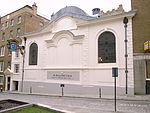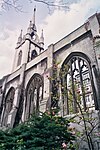Billingsgate
Use British English from November 2014Wards of the City of London

Billingsgate is one of the 25 Wards of the City of London. Its name derives from being the City's original water gate, and this small City Ward is situated on the north bank of the River Thames between London Bridge and Tower Bridge in the south-east of the Square Mile. The modern Ward extends south to the Thames, west to Lovat Lane and Rood Lane, north to Fenchurch Street and Dunster Court, and east to Mark Lane and St Dunstan's Hill.
Excerpt from the Wikipedia article Billingsgate (License: CC BY-SA 3.0, Authors, Images).Billingsgate
St. Mary at Hill, City of London
Geographical coordinates (GPS) Address Nearby Places Show on map
Geographical coordinates (GPS)
| Latitude | Longitude |
|---|---|
| N 51.5095 ° | E -0.0837 ° |
Address
Premier Inn London Bank (Tower)
St. Mary at Hill
EC3R 8EE City of London
England, United Kingdom
Open on Google Maps











